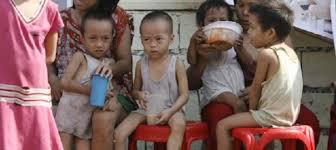
Child malnutrition cost the Philippines $7 billion or nearly 3 percent of its GDP in one year in terms of education spending and lost productivity, while hunger-related stunting is on the rise among children, a global aid agency said on Tuesday.
A report by Save the Children found that the combined losses, calculated with data from 2013, are more than triple the cost of damage inflicted by 15 natural disasters that hit the Southeast Asian country last year.
"Stunting costs are a drag on the economy and impacts all of us, not just the child and the family. It keeps the Filipino economy poorer by 3 percent. If you add that up over time - it's an anchor to progress," said Ned Olney, head of Save the Children in the Philippines, by Skype from Manila.
Stunting is defined as low height-for-age and is measured by comparing the height of a child against the international benchmark for a child of the same age.
Caused by a poor diet in a child's first 1,000 days of life, stunting has severe, irreversible consequences on physical health and cognitive functioning.
The report, citing government data, said that after 25 years of steady improvement, the prevalence of stunting among Filipino children under five increased to 33 percent in 2015 from 30 percent in 2013.
"That's a 10 percent increase in a two-year period, so that is devastating. We're going in the wrong direction," Olney said.
"Even though you have an economy that's humming along at 6 to 7 percent a year, you have an increase in poverty from 24 to 25 percent of all families, and you haven't addressed the issue of access to food."
The report said of the estimated 49,000 students who had to repeat a grade level in school, 15 percent repeated as a result of under-five stunting. It estimated that $27 million was required to cover the costs of grade repetitions for these stunted children.
It calculated lost productivity at $7 billion based on reduced productivity among stunted workers and complete loss of productivity due to premature under-five child deaths linked to hunger.
Meanwhile, urban poverty and hunger are worsening, Olney said. In the past, Save the Children had focused feeding programmers on rural areas but this year started providing emergency food therapy for "starving, skeletal children" in urban areas.
Yet the hardest hit area remains the conflict-plagued island of Mindanao, where 40 percent of children are stunted - an average seen in sub-Saharan Africa, he said.
Save the Children called for more investment in nutrition programs for pregnant and lactating mothers and babies in their first 1,000 days.
Olney also urged the government to address issues such as water and sanitation, agriculture, education and investment in overall productivity.
"Malnutrition is seen as disease burden to be handled by the department of health. We know that doesn't work," he said.
"That's treating the sick child, rather than understanding why the child is malnourished. Countries that address poverty and access to food have made progress in reducing malnutrition."
Source: Reuters
 FR
FR EN
EN AR
AR








